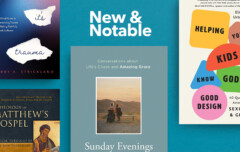Damage Control makes for a good half-book. Were we to skim a little from the early pages and cut a few chapters from the back it would really be quite good. Somewhat unfortunately, the book is 170 pages rather than 80 or 90.
Damage Control is a book that seeks to help Christians stop making Jesus look bad. And surely we can all learn to be more effective, consistent witnesses of His power and grace. Christians seem to excel at making Jesus look bad. But it is not all bad news. Thankfully there are also many occasions when we bring great honor to His name. The author, Dean Merrill says, “In this book I want to look at both sides. I don’t plan only to criticize and critique. While I will honestly examine the ways we hurt God’s cause without realizing it, I also want to showcase the good things being done by today’s ambassadors… I hope that, as a result, we can all become more of the solution and less of the problem.”
The book is divided into three sections. In the first, “God’s Shaky Plan,” Merrill teaches that we are God’s “plan A” for representing Him now that He has left the earth. There is no “plan B.” We are His ambassadors, charged with honestly and carefully representing Him. He writes about the “Christian brand” and how important it is that all Christians remain consistent in their representation of Christ so that unbelievers will see that Christ-followers are the same whether they are Canadian, American or African. He writes about the inevitable offense of the gospel but warns that the offense is to be in the message rather than the messenger. “If someone wishes to reject Jesus because he claimed to be the only way to God, so be it. But let them never reject Jesus because his truth was garbled or poorly demonstrated by a human spokesperson.”
In the second section, “Unintended Hindrances,” Merrill discusses some of the things that can serve as hindrances in our times spent sharing the gospel. He writes about communication and warns that we need to understand that words matter. We need to avoid words that mystify (assuming, for example, that unbelievers know what AWANA is or what the King James Version is), words that overwhelm (rejoicing in the face of a disaster that may allow inroads into a particular area or culture), words that antagonize (a bumper sticker that reads only “God created Adam and Eve, not Adam and Steve”) or words that manipulate (which are often used by televangelists to enrich themselves while promising spiritual blessings). He encourages Christians to major in the majors and not to allow petty doctrinal disputes to prove divisive. Finally, he begs for consistency in the way Christians live and act. This section was incisive and challenging and I very much enjoyed it.
In the final section, “Envoys of Heaven,” the author suggests ways in which Christians can take action to help God’s cause in the world. He presents a mixed bag of good and bad. For example, he presses the importance of “peace on the inside,” showing how often Jesus escaped to the wilderness for time alone. Unfortunately he encourages the reader to follow the example of Henri Nouwen, whose contemplative silence was far different from what Jesus experienced or practiced. He presents Mother Teresa as the example to follow in living what we believe (Note to authors: it’s time to get over her). He quotes Phillip Yancey, Tony Campolo and other authors of dubious spiritual distinction. This section, the climax of the book, was quite a disappointment.
While I generally agree with Merrill in his assessment of the problem, I am far less taken with his proposed cure. Will this book help Christians stop making Jesus look bad? I suspect that on the whole it will. Yet some of the solutions he proposes will introduce new and difficult problems. Are we to emulate Mother Teresa in forsaking doctrine and embracing other religions? Are we to follow Henri Nouwen in his contemplative prayer or only in enjoying times of solitude? I wish Merrill had done a better job of pointing people back to the Scriptures rather than pointing them to the easy and far-too-typical Christian and pseudo-Christian examples.
Despite those problems I did enjoy the book and am confident I benefitted from it. It gave me much to think about and I would have little trouble with recommending it to discerning readers. It will be available at retail outlets late next month.










